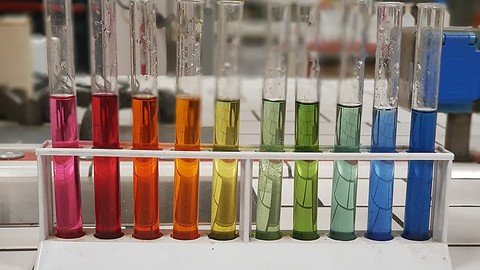Ph Introduction , Basic Concepts And Applications

Free Download Ph Introduction , Basic Concepts And Applications
Published 6/2023
MP4 | Video: h264, 1280x720 | Audio: AAC, 44.1 KHz
Language: English | Size: 353.24 MB | Duration: 1h 9m
pH : Introduction , Basic concepts and Applications
What you'll learn
Introduction to pH
Definition of pH
Basic concepts and pH Scale
Applications of pH
Requirements
No prior knowledge needed .
Description
pH, quantitative measure of the acidity or basicity of aqueous or other liquid solutions. The term, widely used in chemistry, biology, and agronomy, translates the values of the concentration of the hydrogen ion—which ordinarily ranges between about 1 and 10−14 gram-equivalents per litre—into numbers between 0 and 14. In pure water, which is neutral (neither acidic nor alkaline), the concentration of the hydrogen ion is 10−7 gram-equivalents per litre, which corresponds to a pH of 7. A solution with a pH less than 7 is considered acidic; a solution with a pH greater than 7 is considered basic, or alkaline.The measurement was originally used by the Danish biochemist S.P.L. Sørensen to represent the hydrogen ion concentration, expressed in equivalents per litre, of an aqueous solution: pH = −log[H+] (in expressions of this kind, enclosure of a chemical symbol within square brackets denotes that the concentration of the symbolized species is the quantity being considered).Because of uncertainty about the physical significance of the hydrogen ion concentration, the definition of the pH is an operational one; i.e., it is based on a method of measurement. The U.S. National Institute of Standards and Technology has defined pH values in terms of the electromotive force existing between certain standard electrodes in specified solutions.pH meterpH meterThe pH is usually measured with a pH meter, which translates into pH readings the difference in electromotive force (electrical potential or voltage) between suitable electrodes placed in the solution to be tested. Fundamentally, a pH meter consists of a voltmeter attached to a pH-responsive electrode and a reference (unvarying) electrode. The pH-responsive electrode is usually glass, and the reference is usually a mercury-mercurous chloride (calomel) electrode, although a silver-silver chloride electrode is sometimes used. When the two electrodes are immersed in a solution, they act as a battery. The glass electrode develops an electric potential (charge) that is directly related to the hydrogen-ion activity in the solution, and the voltmeter measures the potential difference between the glass and reference electrodes. The meter may have either a digital or an analog (scale and deflected needle) readout. Digital readouts have the advantage of exactness, while analog readouts give better indications of rates of change. Battery-powered portable pH meters are widely used for field tests of the pH of soils. Tests of pH may also be performed, less accurately, with litmus paper or by mixing indicator dyes in liquid suspensions and matching the resulting colours against a colour chart calibrated in pH.In agriculture, the pH is probably the most important single property of the moisture associated with a soil, since that indication reveals what crops will grow readily in the soil and what adjustments must be made to adapt it for growing any other crops. Acidic soils are often considered infertile, and so they are for most conventional agricultural crops, although conifers and many members of the family Ericaceae, such as blueberries, will not thrive in alkaline soil. Acidic soil can be "sweetened," or neutralized, by treating it with lime. As soil acidity increases so does the solubility of aluminum and manganese in the soil, and many plants (including agricultural crops) will tolerate only slight quantities of those metals. Acid content of soil is heightened by the decomposition of organic material by microbial action, by fertilizer salts that hydrolyze or nitrify, by oxidation of sulfur compounds when salt marshes are drained for use as farmland, and by other causes.
Overview
Section 1: Introduction
Lecture 1 Introduction
Section 2: pH Basic concepts
Lecture 2 pH Basic concepts : pH scale
Section 3: pH Basic concepts
Lecture 3 pH : Basic concepts : pH Indicators
Section 4: pH : basic concept
Lecture 4 pH : POH and Kw
Section 5: pH of water and Summary
Lecture 5 pH of Water and Summary
Section 6: Effect of Temperature on pH
Lecture 6 Effect of Temperature on pH
Section 7: Examples of pH Applications
Lecture 7 Examples of pH Applications
Course intended for Allied health professionals and health professionals
Homepage
https://www.udemy.com/course/ph-introduction-basic-concepts-and-applications/Buy Premium From My Links To Get Resumable Support,Max Speed & Support Me
Rapidgator
yidku.P..I..B.C.A.A.rar.html
Uploadgig
yidku.P..I..B.C.A.A.rar
NitroFlare
yidku.P..I..B.C.A.A.rar
Links are Interchangeable - Single Extraction
Free Download Ph Introduction , Basic Concepts And Applications is known for its high-speed downloads. It uses multiple file hosting services such as Rapidgator.net, Nitroflare.com, Uploadgig.com, and Mediafire.com to host its files